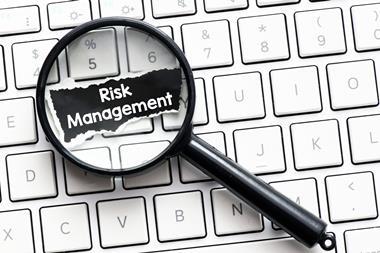The public expects ’insurers to lean into the challenges posed’ by systemic risks and work to develop solutions, says ABI’s director of GI policy
An asteroid the size of Texas is heading towards Earth – if it were to impact the planet, then life as we know it would be wiped out. This is the central conflict of 1998 disaster flick Armageddon.

In the film, an oil driller is transported to the asteroid by the National Aeronautics and Space Administration (Nasa) - he manages to detonate a nuclear explosive inside the giant spaceborne projectile, splitting it in half and saving the planet.
What is less remembered from the film, however, is that meteor showers resulting from the asteroid’s flight had already destroyed large parts of New York City and Shanghai by the time the protagonist completes his mission.
How would insurers respond to such a scenario? Could the insurance sector even hope to address disruption and destruction on this scale without government support?
The destruction of two of the world’s great cities and financial centres by an unprecedented and unexpected threat would fall under the category of a systemic risk – an issue that affects a large sector of society or industries indiscriminately and substantially enough that it could cause market failure of the whole financial system and economy.
The general insurance (GI) industry has recently experienced one such systemic risk.
The Covid-19 pandemic affected society on an unprecedented scale and changed the way that many individuals, especially those working in the GI sector, think about the world.
David Williams, non-executive director at Humn.ai, told Insurance Times that the global economic impact of Covid-19 had reached a figure of around $10tr (£8.2tr), whereas the global capital capacity of insurers typically sits around $2tr (£1.6tr).
He said: “Clearly, this exceeds by some stretch what conventional insurance can cover – it’s something that could have caused market failure and the failure of a number of significant players.”
Speaking during a webinar hosted by the ABI in July 2022, entitled How insurers’ approach to systemic risk is changing and what this means for the general insurance market, the ABI’s director of GI policy, James Dalton, told attendees: “Covid-19 posed some big challenges to businesses across the UK and for many, has led to a reorganisation and restructuring of their business to adapt to the so called ‘new normal’.
“GI has been no different – over the last couple of years the sector has undergone a huge deal of change in almost all areas. Our sector has had time to reflect on its experiences during these turbulent times and how we – as an industry – can approach systemic risk.”
Dalton added that this reflection on the importance of systemic risks had highlighted the importance of insurance and raised some challenging questions around the limits of what the GI sector could provide cover for.
“The public understands that not everything can be insured,” he said. “But they do expect insurers to lean into the challenges posed and work to develop solutions related to systemic risks of all clients.”
Not out of the woods yet
The recent pandemic showed that considering how to respond to systemic risks within the GI sector is anything but academic.
In March 2022, for example, the FCA published updated claims data from insurers that are handling Covid-linked business interruption (BI) claims. This revealed that the total claims payments so far amounted to £1.35bn.
This figure could just be the start of the payouts the GI sector can expect as various litigation is still in progress – Stonegate v Amlin, for example, concerns the pub and restaurant group seeking damages of £845m for business interruption during the pandemic. The case is being heard in the High Court.
Primarily due to confusion around BI policy wordings, GI has suffered reputationally because of the pandemic, with many consumers feeling that insurers should have covered them for Covid-related losses.
Insurers themselves have been put in a difficult position following the FCA’s test case action and resultant judgments, as most did not believe they would be liable for the impact of such a systemic risk, based on their policy wordings.
Being better prepared for the next systemic risk is therefore vital.
Speaking at last month’s ABI webinar, Tom Clementi, chief executive of government-backed terrorism reinsurer Pool Re, said that the top four biggest systemic risks were another pandemic, cyber, an ageing population and climate change.
But how can these issues be addressed and prepared for? Clementi explained: “These perils are big and they’re meaty, so I think it’s important that we break them down into more digestible chunks.
“For the sake of the relevance of our industry, we need to face into these risks, no matter how difficult. If we put watertight exclusions on these policies and run for the hills, then we will cease to be relevant.”
Building a solution
The GI sector is not able to completely address systemic risks alone – definitionally, if a risk is so severe that it would cause the failure of the insurance market, then the insurance market cannot protect against this type of risk by itself.
However, GI can take steps to help protect against systemic risks.
George Beattie, head of incubation underwriting at Beazley, explained: “Tackling systemic risks is challenging because one often finds a low perception of risk among buyers – leading to low demand – and also because rating binary risks that may have no historical precedent leads to arbitrary boom or bust pricing.”

The solution to this, he said, was to gather more data and build more advanced risk profiles on systemic risks.
Caroline Dunn, Zurich’s UK chief underwriting officer, agreed. She said: “We need to quantify the potential impacts of these risks and we need more data to enable us to model and to be able to understand really what the worst that can happen is, to make sure we have enough capital as an industry to be able to provide solutions that many of our customers do want.”
Beattie concurred that data modelling was important and added: “To tackle these issues, we need to break them down into more digestible chunks, which may represent individual, defined products.”
Dunn noted that – in the absence of full data modelling – insurers could help by educating customers on how to become more resilient to systemic risks.
Williams echoed this sentiment. He said: “There are a number of things we can do to help – we can look to provide some protection, but we can also provide risk management advice or use our expertise to tap into other markets and explore alternative risk transfer, for example.”
Government intervention
However, these proposed ideas represent piecemeal solutions to the impact of a systemic risk.
By definition, the GI sector cannot indemnify against something as severe as a pandemic or the destruction of a city in a meteor shower.
Government intervention would be vital in these scenarios – for example, during the Covid-19 pandemic, the UK government stepped in to provide economic protection against societal collapse via measures such as business loans, the furlough scheme and the Trade Credit Reinsurance (TCR) initiative.
Beattie said: “Government has a role to play in moderating and mitigating systemic risks. Arguably, that is one of the core functions of government.
“Insurance has a role to play in this, but [the sector] isn’t a governmental force.”
Williams echoed this. He said: “Insurance can’t cover systemic risks completely and absolutely in a traditional manner – if we said we were going to provide full cover for systemic risks, then the potential losses would exceed our ability to pay.”
There is, therefore, industry-wide consensus that the GI sector cannot cover systemic risks by itself - to do this also requires government intervention, collaboration and support. But what could this look like?
Read: Business school launches new research consortium to better prepare for next systemic risk
Read: Insurance demonstrates it is ‘the shock absorber for the world’ in combating new risks
During the ABI’s webinar, Pool Re was mentioned again and again as an effective example of exactly how the government and the GI sector could collaborate to provide insurance for systemic risks.
In 1993 – when Pool Re was established – terrorism was uninsurable. Today, Pool Re allows for insurance against terrorism of £2.2tr in UK assets backed by an uncapped Treasury guarantee that ensures solvency in the event of any legitimate claim arising from a certified act of terrorism.
The government has not yet had to pay out here, but its status as an insurer of last resort has allowed insurers to provide broad cover against the former systemic risk of terrorism.
Clementi explained: “We very much sit at the intersection between government and the insurance industry – so we’re quite well positioned to play a leading role in helping the industry to develop its thinking around how we tackle systemic risks and provide the blueprint .
“The GI sector needs to work together to find proposals which we can then take to the government and show the extent to which there’s a role for the public sector to play.”
Beattie added: “There needs to be clearer delineation between the role of the government and the role of the industry when it comes to systemic risks in the eyes of intermediaries and buyers – we need to look for answers in the right places otherwise everyone will get frustrated.”












































No comments yet